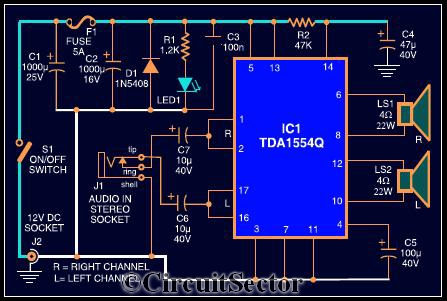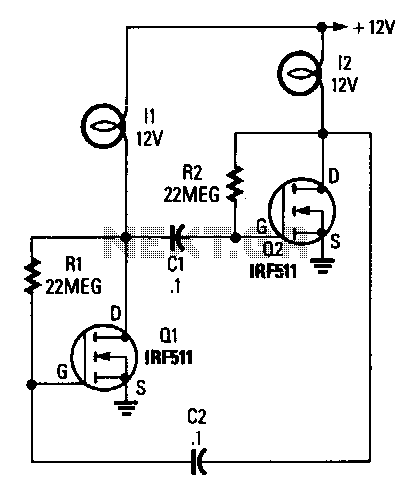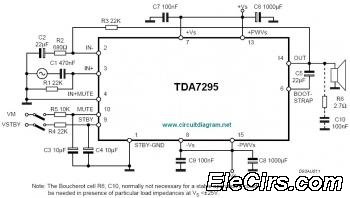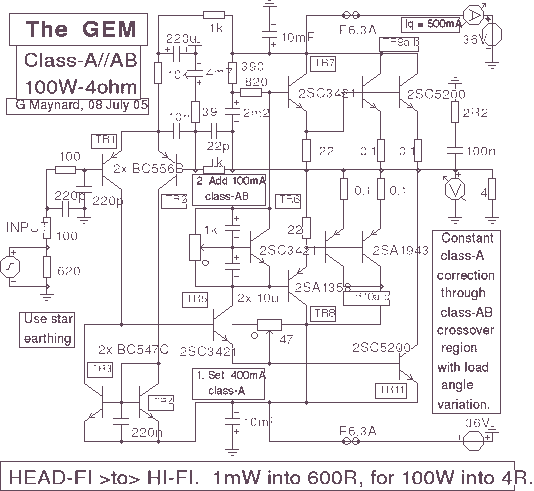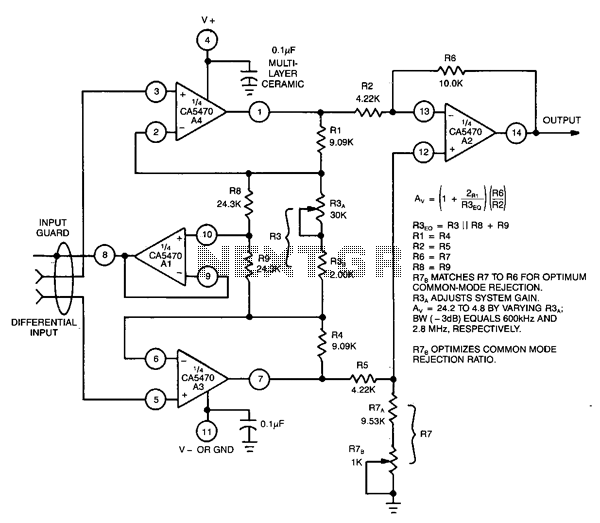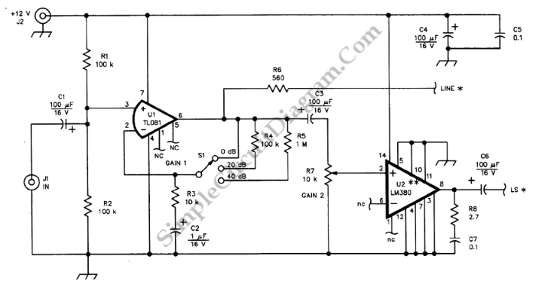
Oatley K272 JAN 6418 Valve (Tube) Preamplifier / Headphone Amp Kit
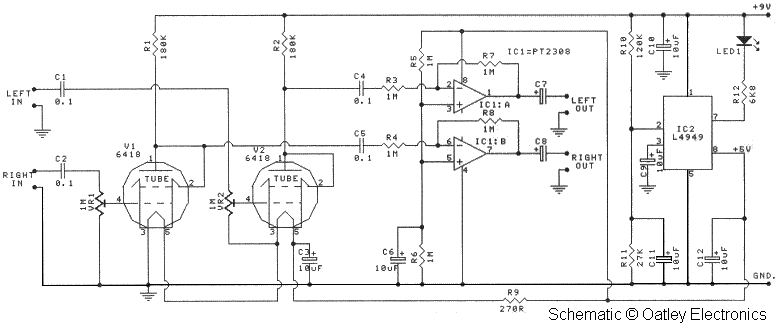
Oatley Electronics, located in New South Wales, Australia, offers several kits based on the Raytheon JAN 6418 sub-miniature valve (tube). The K272A Stereo Tube Preamplifier - Headphone Driver kit, priced at $27 AU, is one such kit. (Note: The K272 has since been succeeded by the K272C Stereo Tube Headphone Amplifier Kit, which is priced at $40 AU as of December 2013.) A photograph of the Oatley Electronics tube preamplifier kit is included. Although the kit is complete, it features generic components, which aligns with its low cost. The printed circuit board (PCB) is dual-layered, plated through, solder masked, and screen printed. This kit operates on a 9V battery, making it a safe and suitable choice for beginners in electronics. Some may be deterred by the kit's low price, but it is noteworthy that the JAN 6418 sub-miniature tube is utilized in the Audio-Technica model AT3060 condenser microphone, which retails for approximately $600 US and is praised for its warm, classic tube sound. The JAN 6418 valves resemble small Christmas tree lights, yet they function as pentodes. Manufactured in the USA, the Raytheon JAN6418 sub-miniature valves consume low power and operate as triodes within the circuit. After assembling one kit, the sound quality was impressive enough to warrant purchasing additional kits for experimentation with higher-quality components. The assembly took just over an hour. The 6418 tube filaments operate at 1.2V and draw only 10mA, producing a faint glow in a dark room and remaining slightly warm to the touch. The entire preamplifier, powered by a single 9V battery, consumes just 12mA. For longer operation, two 9V lithium batteries can be connected in parallel. The 9V supply serves as the B+ (or HT+), while a small 5V regulator chip (L4949) and a 270Ω resistor power the filaments, which are wired in series. The second stage features a low distortion CMOS headphone driver IC (PT2308) configured for unity gain, allowing the preamp to drive both high and low impedance loads, including headphones. The circuit's gain is adjustable from 0 to 7 times and can be increased further if necessary. An LED indicator lights briefly upon activation to signify that the device is on, then only illuminates again when the battery voltage drops below 6.8V. The schematic is provided by Oatley Electronics, with permission to host it on this site. In subsequent builds, carbon resistors were replaced with metal film types, the 0.1µF MKT input and inter-stage capacitors were upgraded to 0.47µF polypropylene film types, the PT2308 headphone driver chip was substituted with a Burr-Brown OPA2134 op-amp, and the 220µF electrolytic output capacitors were also replaced. The valves are highly microphonic and can produce unwanted ringing when struck; thus, rubber grommets are employed to dampen the tubes and eliminate audible noise from mechanical vibrations. With the original PT2308 IC, the kit serves effectively as a headphone driver. While the PT2308 exhibits slightly higher distortion than the OPA2134, it can handle more demanding loads, such as 32-ohm headphones. However, for this specific build intended as a preamp for a valve power amplifier, the OPA2134 is a more suitable option. For gain control, two PCB-mountable potentiometers (pots) were utilized. The kit includes 1M trim pots that can be directly mounted to the PCB in either vertical or horizontal orientation. Although the trim pots are functional for setups where a volume control is available, having physical knobs extending from the front of the enclosure for gain adjustment provides additional convenience.Oatley Electronics in New South Wales Australia makes a few kits based around the Raytheon JAN 6418 sub-miniature valve (tube). I decided to try out the $27AU K272A Stereo Tube Preamplifier - Headphone Driver kit. [Note - the K272 has been replaced with the K272C Stereo Tube Headphone Amplifier Kit which costs $40AU (December 2013).
] A photograph of the Oatley Electronics tube preamplifier kit is shown below. The kit is complete but comes with very ordinary (generic) components which is not surprising considering the very low cost of the kit. The printed circuit board (PCB) is plated through, dual layered, solder masked and screen printed. The kit can be run off a 9V battery which makes this a safe and ideal kit for those who are new to electronics.
Some of you will likely be turned off by the very low cost of this kit. Before you pass judgment on this little kit, do note that Audio-Technica uses a JAN 6418 sub-miniature tube in its model AT3060 condenser microphone which sells for about $600US. Music professionals often describe this microphone as having a warm classic tube sound. These 6418 valves look like small Christmas Tree lights. Hard to believe that they are actually pentodes. The USA made Raytheon JAN6418 sub-miniature valves are low power consumption pentodes that are used as triodes in the circuit.
I built one straight out of the packet and loved the sound so much I decided to get a few more of the kits and try some builds using better parts. It took just over an hour to put the kit together. The 6418 tube filaments are 1. 2V and draw just 10mA. You can barely see the tubes glowing in a dark room and the are just slightly warm to the touch. From a single 9V battery the entire preamplifier draws just 12mA. For a longer run time I used two 9V lithium batteries in parallel. The 9V supply is the B+ (or laughingly HT+) while a small 5V regulator chip (L4949) and 270R resistor feed the filaments which are wired in series.
The second stage is a low distortion CMOS headphone driver IC (PT2308) that is set to unity so the preamp can drive both high and low impedance loads including headphones. The gain of the circuit is adjustable from 0 to 7 times and can be increased further if required. A LED lights for the first few seconds when the device is turned on to show the device is on then it only re-lights when the battery voltage falls below 6.
8V. The schematic is shown in Figure 1. Please note that this circuit is © Oatley Electronics and permission to host the schematic on this site has been provided by Oatley Electronics. For the next build I swapped the all carbon resistors with metal film types, the 0. 1uf MKT input and inter-stage capacitors were replaced with 0. 47uF polypropylene film types, the PT2308 headphone driver chip was swapped out for a Burr-Brown OPA2134 op-amp, and the 220uF electrolytic output capacitors were also replaced.
The valves are extremely microphonic and will "ring" if they are struck so rubber grommets are used to help damp the tubes. This does work and removes all audible noise from mechanical vibrations. With the original PT2308 IC the kit is a capable headphone driver. The PT2308 has only slightly higher distortion figures than the OPA2134 but can drive more demanding loads such as 32 ohm headphones.
Because I am using this build strictly as a preamp (feeding a valve power amp) the OPA2134 is a better choice. For the gain control I used are two PCB mountable potentiometers (pots). The kit comes with 1M trim pots which mount direct to the PCB which will accommodate either vertical or horizontal mounting trim pots.
The trim pots would work for me as my Oppo 980H (modified by Custom Analogue) CD/DVD player has a volume control but there are times when twisting a knob to get desired volume level has its advantages. So I used two small knobs extending out the front of the enclosure to facilitate gain setting. They are not intended t 🔗 External reference
] A photograph of the Oatley Electronics tube preamplifier kit is shown below. The kit is complete but comes with very ordinary (generic) components which is not surprising considering the very low cost of the kit. The printed circuit board (PCB) is plated through, dual layered, solder masked and screen printed. The kit can be run off a 9V battery which makes this a safe and ideal kit for those who are new to electronics.
Some of you will likely be turned off by the very low cost of this kit. Before you pass judgment on this little kit, do note that Audio-Technica uses a JAN 6418 sub-miniature tube in its model AT3060 condenser microphone which sells for about $600US. Music professionals often describe this microphone as having a warm classic tube sound. These 6418 valves look like small Christmas Tree lights. Hard to believe that they are actually pentodes. The USA made Raytheon JAN6418 sub-miniature valves are low power consumption pentodes that are used as triodes in the circuit.
I built one straight out of the packet and loved the sound so much I decided to get a few more of the kits and try some builds using better parts. It took just over an hour to put the kit together. The 6418 tube filaments are 1. 2V and draw just 10mA. You can barely see the tubes glowing in a dark room and the are just slightly warm to the touch. From a single 9V battery the entire preamplifier draws just 12mA. For a longer run time I used two 9V lithium batteries in parallel. The 9V supply is the B+ (or laughingly HT+) while a small 5V regulator chip (L4949) and 270R resistor feed the filaments which are wired in series.
The second stage is a low distortion CMOS headphone driver IC (PT2308) that is set to unity so the preamp can drive both high and low impedance loads including headphones. The gain of the circuit is adjustable from 0 to 7 times and can be increased further if required. A LED lights for the first few seconds when the device is turned on to show the device is on then it only re-lights when the battery voltage falls below 6.
8V. The schematic is shown in Figure 1. Please note that this circuit is © Oatley Electronics and permission to host the schematic on this site has been provided by Oatley Electronics. For the next build I swapped the all carbon resistors with metal film types, the 0. 1uf MKT input and inter-stage capacitors were replaced with 0. 47uF polypropylene film types, the PT2308 headphone driver chip was swapped out for a Burr-Brown OPA2134 op-amp, and the 220uF electrolytic output capacitors were also replaced.
The valves are extremely microphonic and will "ring" if they are struck so rubber grommets are used to help damp the tubes. This does work and removes all audible noise from mechanical vibrations. With the original PT2308 IC the kit is a capable headphone driver. The PT2308 has only slightly higher distortion figures than the OPA2134 but can drive more demanding loads such as 32 ohm headphones.
Because I am using this build strictly as a preamp (feeding a valve power amp) the OPA2134 is a better choice. For the gain control I used are two PCB mountable potentiometers (pots). The kit comes with 1M trim pots which mount direct to the PCB which will accommodate either vertical or horizontal mounting trim pots.
The trim pots would work for me as my Oppo 980H (modified by Custom Analogue) CD/DVD player has a volume control but there are times when twisting a knob to get desired volume level has its advantages. So I used two small knobs extending out the front of the enclosure to facilitate gain setting. They are not intended t 🔗 External reference
Warning: include(partials/cookie-banner.php): Failed to open stream: Permission denied in /var/www/html/nextgr/view-circuit.php on line 713
Warning: include(): Failed opening 'partials/cookie-banner.php' for inclusion (include_path='.:/usr/share/php') in /var/www/html/nextgr/view-circuit.php on line 713
